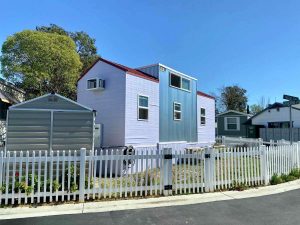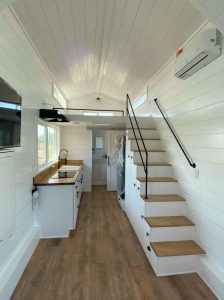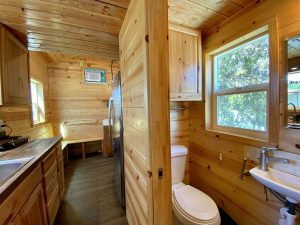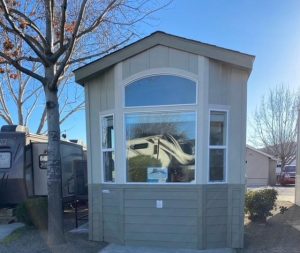With California still in the midst of a deepening housing crisis, some would-be homeowners facing insurmountable barriers to buying a traditional dwelling are turning to tiny homes — with a smaller footprint and a smaller price point to match.
Over the last few years, there has been an increasing interest — and demand for — tiny home living, particularly across the Bay Area, real estate agents say. To keep up with that demand, the marketplace has gotten hotter, and is churning out new manufacturers and sellers everyday.
Some sellers offer plots where people can live after buying their tiny home. Others require them to be shipped or trucked to land that the buyers own.
But with that demand also comes supply issues. Companies like Pacifica Tiny Homes, which builds and sells a variety of model tiny homes that ship to customers nationwide, say there’s a six month wait time for one of their custom-built homes.
This is in part what’s spurring a lot of buyers to look into direct buyers through websites like Tiny House Listings, where a 324-square foot redwood cottage can sell for upwards of $300,000.
So what’s available in the Bay Area when it comes to tiny home living? Here are a few properties that illustrate the sheer scale of how the market is growing.
 129 Katherine Pl, Unit 59, Windsor
• 1 bedroom, 1 bath
• 192 square feet
• Listed at: $95,000
• Price per square foot: $495
In the eight days this tiny home — which is actually a manufactured home on wheels — has been on the market, listing agent Marisa Rosas says she’s already received more than 30 phone calls about it and has given 15 showings.
Most of the people interested are older than 65, and are looking to downsize or move the property to land they either own or can otherwise live on. But if a buyer doesn’t have that option, they can stay on this lot, which is zoned specifically for a tiny home and rents for $631 a month at Royal Mobile Manor, the all age RV park in Windsor.
The solid 2×4 wood throughout, in-unit laundry, butcher block countertops and yard space are just some of the elements drawing so many customers to her listing, Rosas said. But at nearly $100,000, Rosas knows that their asking price is high — though, she says, it’s never been a better time to roll the dice.
“I told my client, this market is a really interesting one right now, and that if (they) wanted to try a number, they could try it now.”
129 Katherine Pl, Unit 59, Windsor
• 1 bedroom, 1 bath
• 192 square feet
• Listed at: $95,000
• Price per square foot: $495
In the eight days this tiny home — which is actually a manufactured home on wheels — has been on the market, listing agent Marisa Rosas says she’s already received more than 30 phone calls about it and has given 15 showings.
Most of the people interested are older than 65, and are looking to downsize or move the property to land they either own or can otherwise live on. But if a buyer doesn’t have that option, they can stay on this lot, which is zoned specifically for a tiny home and rents for $631 a month at Royal Mobile Manor, the all age RV park in Windsor.
The solid 2×4 wood throughout, in-unit laundry, butcher block countertops and yard space are just some of the elements drawing so many customers to her listing, Rosas said. But at nearly $100,000, Rosas knows that their asking price is high — though, she says, it’s never been a better time to roll the dice.
“I told my client, this market is a really interesting one right now, and that if (they) wanted to try a number, they could try it now.”
 Pacifica Tiny Homes
• 1 bedroom – 2 bedroom, one bath
• 211-363 square feet
• $39,900 – $80,900
Having just started in 2018, Pacifica Tiny Homes is one example of the types of companies emerging to the meet the growing demand for simpler and more affordable living. While based out of Pacifica, their factory operations are in Corcoran (Kings County), and the custom-built trailer tiny homes have been shipped all over the Bay Area, said co-owner Crystal Serrano, who started the company with her husband. They’re also the first tiny home company to have their plans approved by the state of California for their homes to be used as accessory dwelling units, Serrano said.
They offer more than 30 different design and 120 color and material options, and the tiny homes can range in length from 18’ to 30’.
Each of their three models come furnished with a smart TV, a AC/Heating unit, and an Ikea queen sized sofa bed. Some can accommodate up to three sleeping spaces.
Pacifica Tiny Homes
• 1 bedroom – 2 bedroom, one bath
• 211-363 square feet
• $39,900 – $80,900
Having just started in 2018, Pacifica Tiny Homes is one example of the types of companies emerging to the meet the growing demand for simpler and more affordable living. While based out of Pacifica, their factory operations are in Corcoran (Kings County), and the custom-built trailer tiny homes have been shipped all over the Bay Area, said co-owner Crystal Serrano, who started the company with her husband. They’re also the first tiny home company to have their plans approved by the state of California for their homes to be used as accessory dwelling units, Serrano said.
They offer more than 30 different design and 120 color and material options, and the tiny homes can range in length from 18’ to 30’.
Each of their three models come furnished with a smart TV, a AC/Heating unit, and an Ikea queen sized sofa bed. Some can accommodate up to three sleeping spaces.
 On the highest end, their 2.0 Tiny Victorian model — which is named because of its gabled-style roof — comes with two loft sleeping or storage spaces, and a propane tankless water heater.
Serrano says Bay Area customers make up at least 50% of their overall sales, and though many of their buyers are older and looking to downsize, many of them are also younger and building families.
“When COVID hit, we saw a bit of a lull and we didn’t know what was going to happen,” said Serrano. “It’s just skyrocketed since then, because there is obviously a high need for housing in the state and this has become an affordable way for a lot of people, young and old.”
Unlike the Windsor property, people are on their own when it comes to finding a place to live in the tiny home, but Serrano says many of their customers have found luck finding rental spots on Craigslist, finding RV parks that are accepting tiny homes, or joining tiny home communities like one in Delta Bay in Isleton.
And because the company handles all of the design and construction, customers are also able to customize the models even further, said Serrano, adding that one buyer, a nurse who worked long hours, requested her tiny home be built with a bathtub.
On the highest end, their 2.0 Tiny Victorian model — which is named because of its gabled-style roof — comes with two loft sleeping or storage spaces, and a propane tankless water heater.
Serrano says Bay Area customers make up at least 50% of their overall sales, and though many of their buyers are older and looking to downsize, many of them are also younger and building families.
“When COVID hit, we saw a bit of a lull and we didn’t know what was going to happen,” said Serrano. “It’s just skyrocketed since then, because there is obviously a high need for housing in the state and this has become an affordable way for a lot of people, young and old.”
Unlike the Windsor property, people are on their own when it comes to finding a place to live in the tiny home, but Serrano says many of their customers have found luck finding rental spots on Craigslist, finding RV parks that are accepting tiny homes, or joining tiny home communities like one in Delta Bay in Isleton.
And because the company handles all of the design and construction, customers are also able to customize the models even further, said Serrano, adding that one buyer, a nurse who worked long hours, requested her tiny home be built with a bathtub.
 Harmony Communities
• Studio – 2 bedroom
• 220-400 square feet
• $67,500-$99,950
Like Pacifica Tiny Homes, Harmony Communities — one of the largest tiny home purchasers in the state — offers a few different models for their customers to choose from, though they’re not as customize-able.
The company, which is based out of Stockton, works with two factories in Lindsey (Tulare County) and Corona (Riverside County).
“They cannot get us homes fast enough,” said President Matthew Davies. “We are six to nine months out on our orders.”
The reason, he says, echoes a narrative that has come to explain the tiny home craze: affordability, at least by Bay Area standards.
“It’s impossible (here),” said Davies, referring to the Bay Area’s housing crisis. “These are your bread-and-butter, blue collar workers who are buying these … these are the workers who don’t have telecommuting jobs.”
For many white-collar workers, and especially those able to tele-commuting, the defining trend over the pandemic was to find more space, not less. But for working class Bay Area residents finding themselves increasingly priced out of cities they are tied to, tiny home living has become one of their only options for home ownership, said Davies.
The company sells about four properties a month to Bay Area buyers in three different park communities: Gilroy Garlic Farm, Bayshore Commons in San Leandro, and Creekside Village MHC in San Pablo. The properties are fairly austere, but sometimes include some added flourishes, like a wrap-around porch and additional loft units that can accomodate families of up to 4, sometimes 5 people.
“The model works best for the Bay Area,” he said. “Because land is scarce and prices are already high.”
Harmony Communities
• Studio – 2 bedroom
• 220-400 square feet
• $67,500-$99,950
Like Pacifica Tiny Homes, Harmony Communities — one of the largest tiny home purchasers in the state — offers a few different models for their customers to choose from, though they’re not as customize-able.
The company, which is based out of Stockton, works with two factories in Lindsey (Tulare County) and Corona (Riverside County).
“They cannot get us homes fast enough,” said President Matthew Davies. “We are six to nine months out on our orders.”
The reason, he says, echoes a narrative that has come to explain the tiny home craze: affordability, at least by Bay Area standards.
“It’s impossible (here),” said Davies, referring to the Bay Area’s housing crisis. “These are your bread-and-butter, blue collar workers who are buying these … these are the workers who don’t have telecommuting jobs.”
For many white-collar workers, and especially those able to tele-commuting, the defining trend over the pandemic was to find more space, not less. But for working class Bay Area residents finding themselves increasingly priced out of cities they are tied to, tiny home living has become one of their only options for home ownership, said Davies.
The company sells about four properties a month to Bay Area buyers in three different park communities: Gilroy Garlic Farm, Bayshore Commons in San Leandro, and Creekside Village MHC in San Pablo. The properties are fairly austere, but sometimes include some added flourishes, like a wrap-around porch and additional loft units that can accomodate families of up to 4, sometimes 5 people.
“The model works best for the Bay Area,” he said. “Because land is scarce and prices are already high.”
 129 Katherine Pl, Unit 59, Windsor
• 1 bedroom, 1 bath
• 192 square feet
• Listed at: $95,000
• Price per square foot: $495
In the eight days this tiny home — which is actually a manufactured home on wheels — has been on the market, listing agent Marisa Rosas says she’s already received more than 30 phone calls about it and has given 15 showings.
Most of the people interested are older than 65, and are looking to downsize or move the property to land they either own or can otherwise live on. But if a buyer doesn’t have that option, they can stay on this lot, which is zoned specifically for a tiny home and rents for $631 a month at Royal Mobile Manor, the all age RV park in Windsor.
The solid 2×4 wood throughout, in-unit laundry, butcher block countertops and yard space are just some of the elements drawing so many customers to her listing, Rosas said. But at nearly $100,000, Rosas knows that their asking price is high — though, she says, it’s never been a better time to roll the dice.
“I told my client, this market is a really interesting one right now, and that if (they) wanted to try a number, they could try it now.”
129 Katherine Pl, Unit 59, Windsor
• 1 bedroom, 1 bath
• 192 square feet
• Listed at: $95,000
• Price per square foot: $495
In the eight days this tiny home — which is actually a manufactured home on wheels — has been on the market, listing agent Marisa Rosas says she’s already received more than 30 phone calls about it and has given 15 showings.
Most of the people interested are older than 65, and are looking to downsize or move the property to land they either own or can otherwise live on. But if a buyer doesn’t have that option, they can stay on this lot, which is zoned specifically for a tiny home and rents for $631 a month at Royal Mobile Manor, the all age RV park in Windsor.
The solid 2×4 wood throughout, in-unit laundry, butcher block countertops and yard space are just some of the elements drawing so many customers to her listing, Rosas said. But at nearly $100,000, Rosas knows that their asking price is high — though, she says, it’s never been a better time to roll the dice.
“I told my client, this market is a really interesting one right now, and that if (they) wanted to try a number, they could try it now.”
 Pacifica Tiny Homes
• 1 bedroom – 2 bedroom, one bath
• 211-363 square feet
• $39,900 – $80,900
Having just started in 2018, Pacifica Tiny Homes is one example of the types of companies emerging to the meet the growing demand for simpler and more affordable living. While based out of Pacifica, their factory operations are in Corcoran (Kings County), and the custom-built trailer tiny homes have been shipped all over the Bay Area, said co-owner Crystal Serrano, who started the company with her husband. They’re also the first tiny home company to have their plans approved by the state of California for their homes to be used as accessory dwelling units, Serrano said.
They offer more than 30 different design and 120 color and material options, and the tiny homes can range in length from 18’ to 30’.
Each of their three models come furnished with a smart TV, a AC/Heating unit, and an Ikea queen sized sofa bed. Some can accommodate up to three sleeping spaces.
Pacifica Tiny Homes
• 1 bedroom – 2 bedroom, one bath
• 211-363 square feet
• $39,900 – $80,900
Having just started in 2018, Pacifica Tiny Homes is one example of the types of companies emerging to the meet the growing demand for simpler and more affordable living. While based out of Pacifica, their factory operations are in Corcoran (Kings County), and the custom-built trailer tiny homes have been shipped all over the Bay Area, said co-owner Crystal Serrano, who started the company with her husband. They’re also the first tiny home company to have their plans approved by the state of California for their homes to be used as accessory dwelling units, Serrano said.
They offer more than 30 different design and 120 color and material options, and the tiny homes can range in length from 18’ to 30’.
Each of their three models come furnished with a smart TV, a AC/Heating unit, and an Ikea queen sized sofa bed. Some can accommodate up to three sleeping spaces.
 On the highest end, their 2.0 Tiny Victorian model — which is named because of its gabled-style roof — comes with two loft sleeping or storage spaces, and a propane tankless water heater.
Serrano says Bay Area customers make up at least 50% of their overall sales, and though many of their buyers are older and looking to downsize, many of them are also younger and building families.
“When COVID hit, we saw a bit of a lull and we didn’t know what was going to happen,” said Serrano. “It’s just skyrocketed since then, because there is obviously a high need for housing in the state and this has become an affordable way for a lot of people, young and old.”
Unlike the Windsor property, people are on their own when it comes to finding a place to live in the tiny home, but Serrano says many of their customers have found luck finding rental spots on Craigslist, finding RV parks that are accepting tiny homes, or joining tiny home communities like one in Delta Bay in Isleton.
And because the company handles all of the design and construction, customers are also able to customize the models even further, said Serrano, adding that one buyer, a nurse who worked long hours, requested her tiny home be built with a bathtub.
On the highest end, their 2.0 Tiny Victorian model — which is named because of its gabled-style roof — comes with two loft sleeping or storage spaces, and a propane tankless water heater.
Serrano says Bay Area customers make up at least 50% of their overall sales, and though many of their buyers are older and looking to downsize, many of them are also younger and building families.
“When COVID hit, we saw a bit of a lull and we didn’t know what was going to happen,” said Serrano. “It’s just skyrocketed since then, because there is obviously a high need for housing in the state and this has become an affordable way for a lot of people, young and old.”
Unlike the Windsor property, people are on their own when it comes to finding a place to live in the tiny home, but Serrano says many of their customers have found luck finding rental spots on Craigslist, finding RV parks that are accepting tiny homes, or joining tiny home communities like one in Delta Bay in Isleton.
And because the company handles all of the design and construction, customers are also able to customize the models even further, said Serrano, adding that one buyer, a nurse who worked long hours, requested her tiny home be built with a bathtub.
 Harmony Communities
• Studio – 2 bedroom
• 220-400 square feet
• $67,500-$99,950
Like Pacifica Tiny Homes, Harmony Communities — one of the largest tiny home purchasers in the state — offers a few different models for their customers to choose from, though they’re not as customize-able.
The company, which is based out of Stockton, works with two factories in Lindsey (Tulare County) and Corona (Riverside County).
“They cannot get us homes fast enough,” said President Matthew Davies. “We are six to nine months out on our orders.”
The reason, he says, echoes a narrative that has come to explain the tiny home craze: affordability, at least by Bay Area standards.
“It’s impossible (here),” said Davies, referring to the Bay Area’s housing crisis. “These are your bread-and-butter, blue collar workers who are buying these … these are the workers who don’t have telecommuting jobs.”
For many white-collar workers, and especially those able to tele-commuting, the defining trend over the pandemic was to find more space, not less. But for working class Bay Area residents finding themselves increasingly priced out of cities they are tied to, tiny home living has become one of their only options for home ownership, said Davies.
The company sells about four properties a month to Bay Area buyers in three different park communities: Gilroy Garlic Farm, Bayshore Commons in San Leandro, and Creekside Village MHC in San Pablo. The properties are fairly austere, but sometimes include some added flourishes, like a wrap-around porch and additional loft units that can accomodate families of up to 4, sometimes 5 people.
“The model works best for the Bay Area,” he said. “Because land is scarce and prices are already high.”
Harmony Communities
• Studio – 2 bedroom
• 220-400 square feet
• $67,500-$99,950
Like Pacifica Tiny Homes, Harmony Communities — one of the largest tiny home purchasers in the state — offers a few different models for their customers to choose from, though they’re not as customize-able.
The company, which is based out of Stockton, works with two factories in Lindsey (Tulare County) and Corona (Riverside County).
“They cannot get us homes fast enough,” said President Matthew Davies. “We are six to nine months out on our orders.”
The reason, he says, echoes a narrative that has come to explain the tiny home craze: affordability, at least by Bay Area standards.
“It’s impossible (here),” said Davies, referring to the Bay Area’s housing crisis. “These are your bread-and-butter, blue collar workers who are buying these … these are the workers who don’t have telecommuting jobs.”
For many white-collar workers, and especially those able to tele-commuting, the defining trend over the pandemic was to find more space, not less. But for working class Bay Area residents finding themselves increasingly priced out of cities they are tied to, tiny home living has become one of their only options for home ownership, said Davies.
The company sells about four properties a month to Bay Area buyers in three different park communities: Gilroy Garlic Farm, Bayshore Commons in San Leandro, and Creekside Village MHC in San Pablo. The properties are fairly austere, but sometimes include some added flourishes, like a wrap-around porch and additional loft units that can accomodate families of up to 4, sometimes 5 people.
“The model works best for the Bay Area,” he said. “Because land is scarce and prices are already high.”